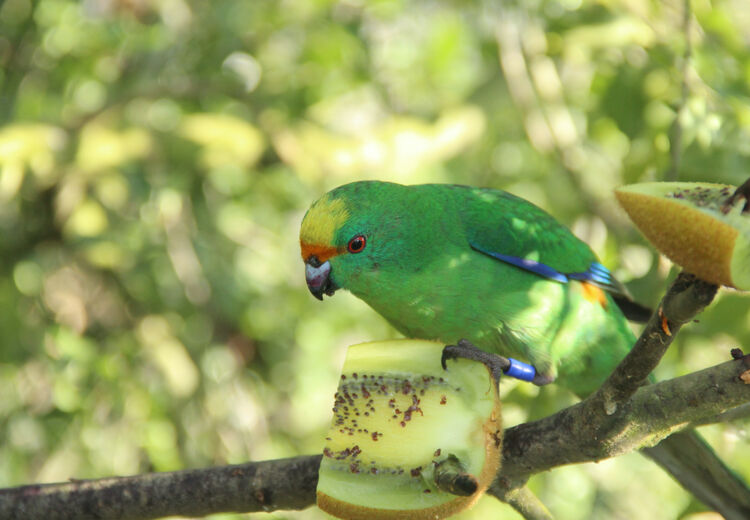Orange-Fronted Parakeet
Common name(s) Orange-fronted Parakeet/Kākāriki Karaka
Scientific name Cyanoramphus malherbi
Threat classification Threatened – nationally critical
Species profile
The Orange-fronted Parakeet (OFP) /Kākāriki Karaka is both New Zealand’s most endangered parakeet species and forest bird species. If not for intensive management and captive breeding, they may have already become extinct.
To the untrained eye, this charismatic species is often confused with their two larger cousins, the Red-crowned and the Yellow-crowned parakeet. However, OFP’s are the smallest of the three species – approximately the size of a budgie with males only weighing around 40-50 grams. Found almost exclusively in Beech forest, breeding proliferation is tied to Beech masts, when food is plentiful. Unfortunately, this abundance of food also increases pest numbers, leading to high levels of predation.
Distribution
Once distributed widely throughout New Zealand, OFP’s are restricted to just a few valleys within Arthurs Pass National Park and Lake Sumner Forest Park in North Canterbury. Translocations have been attempted on several predator free Islands but unfortunately this strategy has not proved effective so far with only one population on Blumine Island being established long term.
Challenges
Many challenges present themselves breeding and managing this species. High attrition, low genetic diversity and a lack of secure release sites all impact the success of this programme. While some pairs can prove to be prolific breeders, others are not and the challenge for ICWT is to maximise breeding output by continuing to refine methods to stimulate breeding in captivity.
Introduced predators are the main threat for the wild population of OFP’s. Females nest in tree cavities which can make them and their nests very vulnerable to predation. Locating and protecting nests is a major priority as well as intensive trapping and other forms of pest control. This is an ongoing challenge due to the scale and remoteness of the area.
ICWT contribution to breeding programme
Until recently ICWT have been the sole captive facility to breed OFP’s. Since 2003, the Trust has bred over 600 birds and contributed significantly to the survival of this species. Multiple breeding pairs are held on site and all offspring produced are either released or retained for the captive breeding programme.
Future aspirations
In recent times, ICWT has begun to convert existing aviaries originally constructed for other species into OFP breeding aviaries. This work, alongside other captive breeding facilities joining the programme, will lead to a major increase in captive breeding capacity, resulting in more captive bred birds available for release into suitable locations.
Partnerships
- Department of Conservation – Species management
- Christchurch Helicopters – transportation to release sites
- Air New Zealand – transportation between captive facilities
- University of Canterbury – Genetic analysis and population management
- Wildbase – Veterinary Advice
- Orana Wildlife Park – Captive Breeding Facility
- Auckland Zoo - Captive Breeding Facility
- Pūkaha National Wildlife Centre - Captive Breeding Facility








